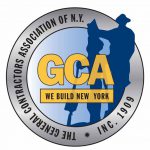We are pleased to announce that Melissa R. Callender-Lee and Michael P. Tobin have become Partners of the firm and Todd A. Paradeis has been elevated to Senior Counsel.
published on December 15, 2010
We are pleased to announce that Melissa R. Callender-Lee and Michael P. Tobin have become Partners of the firm and Todd A. Paradeis has been elevated to Senior Counsel.
published on December 15, 2010
Thomas J. Hall lectured at a Travelers Construction Underwriting seminar entitled “Guidelines for an Effective Contractual Risk Transfer Program,” in New York City.
published on December 09, 2010
Thomas J. Hall lectured at a Travelers Construction Underwriting seminar entitled “Guidelines for an Effective Contractual Risk Transfer Program,” in New York City.
published on December 09, 2010
John V. Fabiani, Jr. lectured at the New York State Bar Association seminar entitled “Construction Site Accidents- 2010 Update,” in New York City.
published on December 03, 2010
John V. Fabiani, Jr. lectured at the New York State Bar Association seminar entitled “Construction Site Accidents- 2010 Update,” in New York City.
published on December 03, 2010
Court Grants City of New York Summary Judgment Dismissing Plaintiff’s Complaint
published on November 18, 2010
Court Grants City of New York Summary Judgment Dismissing Plaintiff’s Complaint
published on November 18, 2010
In a decision dated November 18, 2010, the Appellate Division, First Department, affirmed the trial court’s dismissal of the plaintiff’s complaint. The plaintiff, an ironworker, alleged that while working on a bridge owned by defendant the City of New York, he was struck by a pick-up truck owned and operated by his employer when he attempted to enter a lane of traffic on the bridge that was closed to the public by his employer. The Appellate Division held that the City could not be held liable for common law negligence or pursuant to Labor Law §200 because it did not exercise supervision and control over the plaintiff’s work. Although the City had to approve the plaintiff’s employer’s request to close lanes to public traffic and had hired engineers to ensure that the work was being performed according to the contract plans and specifications, the First Department held that such conduct did not amount to supervision and control over the plaintiff’s work. In addition, the First Department agreed that the jersey barrier over which the plaintiff had to step to enter the roadway was not an inherently dangerous condition in the workplace such that the City could be held liable to the plaintiff, even in the absence of supervisory control over his work. Furthermore, because the City was not the plaintiff’s employer, Labor Law §200 liability could not be based upon alleged violations of the Occupational Safety and Health Act which govern employer/employee relationships. The Appellate Division also determined that Industrial Code Rules 23-1.29 (public vehicular traffic) and 23-1.32 (imminent danger- notice, warning and avoidance) were inapplicable to the facts of this case.
Delaney v. The City of New York, 78 A.D.3d 540 (1st Dep’t 2010)
Thomas J. Hall in conjunction with Travelers lectured at a seminar for J.T. Magen entitled “Accident Response and Investigation,” in New York City.
published on November 17, 2010
Thomas J. Hall in conjunction with Travelers lectured at a seminar for J.T. Magen entitled “Accident Response and Investigation,” in New York City.
published on November 17, 2010
Court Grants City of New York Summary Judgment Dismissing Plaintiff’s Complaint
published on November 17, 2010
Court Grants City of New York Summary Judgment Dismissing Plaintiff’s Complaint
published on November 17, 2010
In a decision dated November 17, 2010, Justice Kevin J. Kerrigan, Queens County Supreme Court, held that the City of New York was entitled to summary judgment dismissing the plaintiff’s complaint alleging common law negligence and violations of Labor Law §§200 and 241(6). The plaintiff was employed as a laborer by Tully Construction. Tully was hired by the New York State Department of Transportation to repave the Grand Central Parkway. The City issued work permits that allowed the State and Tully to enter upon the roadway and restrict the flow of traffic for the repaving project. At the time of the accident, the right and center lanes were closed to public traffic. The plaintiff was straddling the left and center lanes tampering down asphalt when he was struck by a public vehicle traveling at a high rate of speed in the left lane. The plaintiff alleged that the City owned, maintained and controlled the Grand Central Parkway and failed to properly maintain the workplace. However, the evidence established that the State was in charge of the project and the City did not participate in the selection of the contractor, perform any work on the project, plan or inspect the lane closures or the placement of warning signs or other traffic control devices. Rather, the City’s role was largely confined to its regulatory responsibilities of issuing work permits, including the right to issue violations or stop the work if it was not performed in compliance with the terms of the work permit. Citing Albanese v. City of New York, 5 N.Y.3d 217 (2005), the Court held that the City’s limited role could not subject it to absolute liability under Labor Law §§200 or 241(6) for an injury allegedly resulting from the inadequacy of traffic control devices, personnel and/or barricades that were put in place by Tully and inspected or approved by the State. In addition, because the City did not bear responsibility for the manner in which the work was performed or the safety measures employed during the work, the City was entitled to dismissal of the plaintiff’s claims for common law negligence and pursuant to Labor Law §200.
Vinci v. The City of New York et al., Index No. 14730/08 (Queens Co. Sup. Ct., November 17, 2010)
We are pleased to announce that Kenneth J. Kutner has joined the firm as a Partner.
published on November 11, 2010
We are pleased to announce that Kenneth J. Kutner has joined the firm as a Partner.
published on November 11, 2010
Summary Judgment Granted In Favor of Defendant Dismissing Plaintiff’s Causes of Action for Common Law Negligence and Violations of Labor Law §§200, 240(1) and 241(6)
published on November 03, 2010
Summary Judgment Granted In Favor of Defendant Dismissing Plaintiff’s Causes of Action for Common Law Negligence and Violations of Labor Law §§200, 240(1) and 241(6)
published on November 03, 2010
In a decision dated November 3, 2010, Justice David B. Vaughn granted the defendant summary judgment dismissing plaintiff’s claim pursuant to Labor Law §241(6), which was premised on Industrial Code Rules 23-1.7(d) and 23-1.7(e). The plaintiff, an ironworker, claimed that he was holding a tag line for a beam, which was being loaded onto a flat bed trailer when he slipped on oil or fluid and was then struck by a pickup truck which ran over his foot. The defendant demonstrated that the plaintiff could not identify the substance as he never touched it and did not even notice the condition until after the accident. Three co-workers testified that they never observed any substances in the area where the accident occurred. The site safety manager provided an affidavit stating that the plaintiff advised him his accident occurred when he backed up into the truck and was knocked down. The Court found that the Industrial Code Rules alleged could not support the plaintiff’s claim and dismissed the Labor Law §241(6) cause of action. The causes of action for common law negligence and violation of Labor Law §§200 and 240(1) were dismissed without opposition.
Coffin v. The City of New York, Index No. 46071/07 (Kings Co. Sup. Ct., November 3, 2010)
Court Grants City of New York Summary Judgment Dismissing Plaintiff’s Claims for Common Law Negligence and Violation of Labor Law §§200, 240(1) and 241(6) and Defendants’ Motion to Change Venue to Extent of Changing Venue From Bronx County To New York County
published on October 08, 2010
Court Grants City of New York Summary Judgment Dismissing Plaintiff’s Claims for Common Law Negligence and Violation of Labor Law §§200, 240(1) and 241(6) and Defendants’ Motion to Change Venue to Extent of Changing Venue From Bronx County To New York County
published on October 08, 2010
In a decision dated October 8, 2010, Justice Howard H. Sherman granted defendants’ motion to the extent of awarding summary judgment in favor of the City of New York dismissing the plaintiff’s complaint and defendants’ motion to change venue to the extent of changing the venue from Bronx County to New York County. The plaintiff commenced this action in February 2010, after a hearing pursuant to General Municipal Law 50-h was held in January. It is alleged that the City was and is the owner of the premises under construction known as the Alexander Hamilton Bridge in Bronx County. It is also alleged that the City was negligent in the ownership of the premises on which the plaintiff, a construction worker, tripped and fell and that the City violated Labor Law §§200, 240(1) and 241(6). The defendants joined issue with the service of their answer in April of 2010. Along with its answer the defendants served a demand for a change of venue to Suffolk County contending that the plaintiff’s designation of Bronx County was improper. The defendants moved for an order awarding the City summary judgment dismissing the plaintiff’s complaint against it on the grounds that it is not an owner under the terms of the Labor law and otherwise owed no duty of care to the plaintiff. In addition, the defendants moved for a change of the place of the trial of this action from Bronx County to Suffolk County as of right pursuant to CPLR 503, 505, 510(1) and 511(b), and on the grounds that once the City is awarded summary judgment, there is no longer a basis for maintaining venue in Bronx County. The plaintiffs cross-moved for an order denying the defendants’ motion for summary judgment or, alternatively, changing the venue to New York County or granting leave to discontinue the action. The court granted summary judgment to the City which met its burden of proving that it was not an owner of the premises in question. The evidence set forth by the City proved that the Alexander Hamilton Bridge is part of the State Arterial Highway System, and though the City provides routine maintenance of the bridge, the State has the responsibility for the repair work, including the construction project being performed at the time of the plaintiff’s accident. Moreover, the City’s routine maintenance obligations with respect to the bridge area were suspended during the course of the very construction project on which the plaintiff was injured. Regarding the motions to change venue, the court determined that in light of the summary dismissal of the action as against the City, and the settled principle that the benefit of CPLR 504(3) runs not to individual litigants but to the municipality, the court found no basis for the trial of this action against the remaining defendant to be held in Bronx County. Therefore, it decided that venue would be proper in New York County where one of the remaining defendants has its principal place of business.
Murtha v. City of New York et al., Index No. 301594/10 (Bronx Co. Sup. Ct., October 8, 2010)
Court Grants Defendants’ Motion to Change Venue from Bronx County to Nassau County
published on September 30, 2010
Court Grants Defendants’ Motion to Change Venue from Bronx County to Nassau County
published on September 30, 2010
In a decision dated September 30, 2010, Justice Betty Owen Stinson granted the defendants’ motion to change venue from Bronx County to Nassau County. On April 2, 2008, the plaintiff commenced suit by filing a summons and complaint in Bronx County Supreme Court. The basis for venue in Bronx County was plaintiff’s alleged residence in that county. On August 28, 2008, defendants served a demand for a change of venue to Nassau County along with their answer. The plaintiff never responded to the demand for a change of venue. At the plaintiff’s deposition he testified that when the action was commenced he lived in Bronx County, at the home of his cousins. He testified that he moved there in February of 2008, a little more than one month prior to commencement of the lawsuit. Before that, he had lived his entire life in Nassau County. When asked what prompted the move, the plaintiff testified that he was going to have surgery and had to stay with somebody for a few months to look after him for three or four months. On or about February of 2009, the plaintiff moved out of his cousins’ house to another address in the Bronx, but offered no proof of that residence. When asked why he did not return to his parents’ home in Nassau County, he replied that they had moved to Pennsylvania and he wanted to be near his cousins who had been so helpful. On June 26, 2009, the defendants served a motion to change venue. In response to the motion, plaintiff provided copies of a driver’s license and car registration which were issued on February 22, 2008 as documentary proof of his Bronx residence. Those items represented plaintiff’s address to be the home of his cousins. Other items that were offered consisted of correspondence received in the mail after commencement of the lawsuit. Plaintiff had no medical treatment in Bronx County or in the City of New York. All of the treatment took place in Nassau County. Additionally, one of the defendants resided in Nassau County. In granting defendants’ motion to change venue from Bronx County to Nassau County, the court held that plaintiff’s driver’s license and registration, issued on the same date, were not enough alone to establish residency for the purpose of venue in light of plaintiff’s subsequent admission that he never intended to remain with his cousins at the address listed on those documents with any degree of permanency. The court also excused defendants’ delay in bringing the motion due entirely to plaintiff’s evasiveness, willful omissions and misleading statements.
Apicello v. Robert E. Coyles, Tully Construction Co. et al., Index No. 302658/08 (Bronx Co. Sup. Ct., September 30, 2010)








